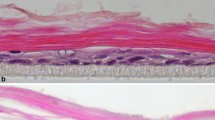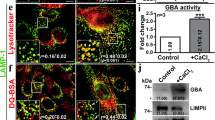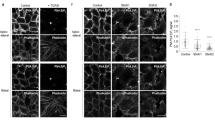Summary
Ethanolamine (Etn) is required for the growth of epitehlial cells in culture. Without Etn, the amount of phosphatidyl-ethanolamine (PE) in membrane lipids is reduced, and cell proliferation stops. When the membrane lipids are deficient of PE, some extracellular signaling processes become impaired. In this study, we examined the effect of Etn deprivation on the formation of intercellular networks in immortalized human oral keratinocytes. Keratinocytes proliferate with undifferentiated morphologies in a low-calcium medium, whereas they undergo differentiation to form intercellular networks in a high-calcium medium. The cells were first cultured with or without Etn supplement in a low-calcium (0.07 mM) medium, and then the calcium concentration was raised to 1.8 mM. The localization and organization of the following proteins were examined: (1) desmogleins and plakoglobin in desmosomes, (2) E-cadherin and β-catenin in adherens junctions and (3) actin and keratin filaments in cytoskeletons. As expected, in the Etn-supplemented cells, the elevated level of calcium induced the junctional localization of the proteins associated with desmosomes and adherens junctions and also induced the formation of keratin and actin networks. On the contrary, in the Etn-deprived cells, the elevated level of calcium induced none of the above processes. The results suggest that having a sufficient amount of PE or proper phospholipid composition in the membranes is crucial for differentiation in epithelial cells.
Similar content being viewed by others
References
Babcock, M. S.; Marino, M. R.; Gunning III, W. T.; Stoner, G. D. Clonal growth and serial propagation of rat esophageal epithelial cells. In Vitro 19:403–415; 1983.
Emoto, K.; Umeda, M. An essential role for a membrane lipid in cytokinesis: regulation of contractile ring disassembly by redistribution of phosphatidylethanolamine. J. Cell Biol. 149:1215–1224; 2000.
Errick, J. E.; Kano-Sueoka, T. Growth responsiveness to prolactin and its loss in normal rat mammary cells in culture. Mol. Cell. Endocrinol. 32:255–270; 1983.
Fisk, H. A.; Kano-Sueoka, T. Effect of membrane phosphatidylethanolamine-deficiency/phosphatidylcholine-excess on the metabolism of phosphatidylcholine and phosphatidylethanolamine. J. Cell. Physiol. 153:589–595; 1992.
Garrod, D.; Chidgey, M.; North, A. Desmosomes: differentiation, development, dynamics and disease. Curr. Opin. Cell Biol. 8:670–678; 1996.
Gumbiner, B. M. Cell adhesion: the molecular basis of tissue architecture and morphogenesis. Cell 84:345–357; 1996.
Hammond, S. L.; Ham, R. G.; Stampfer, M. R. Serum-free growth of human mammary epithelial cells: rapid clonal growth in defined medium and extended serial passage with pituitary extract. Proc. Natl. Acad. Sci. USA 81:5435–5439; 1984.
Kandikonda, S.; Oda, D.; Niederman, R., et al. Cadherin-mediated adhesion is required for normal growth regulation of human gingival epithelial cells. Cell Adhes. Commun. 4:13–24; 1996.
Kano-Sueoka, T.; Cohen, D. M.; Yamaizumi, Z., et al. Phosphoethanolamine as a growth factor of a mammary carcinoma cell line of rat. Proc. Natl. Acad. Sci. USA 76:5741–5744; 1979.
Kano-Sueoka, T.; Errick, J. E. Effects of phosphoethanolamine and ethanolamine on growth of mammary carcinoma cells in culture. Exp. Cell Res. 136:137–145; 1981.
Kano-Sueoka, T.; Errick, J. E.; King, D., et al. Phosphatidylethanolamine synthesis in ethanolamine-responsive and-nonresponsive cells in culture. J. Cell. Physiol. 117:109–115; 1983.
Kano-Sueoka, T.; King, D. M. Phosphatidylethanolamine biosynthesis in rat mammary carcinoma cells that require and do not require ethanolamine for proliferation. J. Biol. Chem. 262:607–6081; 1987.
Kano-Sueoka, T.; King, D. M. Effects of phosphatidylethanolamine and phosphatidylcholine in membrane phospholipid on binding of phorbol ester in rat mammary carcinoma cells. Cancer Res. 48:1528–1532; 1988.
Kano-Sueoka, T.; King, D. M.; Fisk, H. A., et al. Binding of epidermal growth factor to its receptor is affected by membrane phospholipid environment. J. Cell. Physiol. 145:543–548; 1990.
Kano-Sueoka, T.; Nicks, M. E. Abnormal function of protein kinase C in cells having phosphatidylethanolamine-deficient and phosphatidylcholine-excess membranes. Cell Growth Differ. 4:533–537; 1993.
Kowalczyk, A. P.; Bornslaeger, E. A.; Norvell, S. M., et al. Desmosomes: intercellular adhesive junctions specialized for attachment of intermediate filaments. Int. Rev. Cytol. 185:237–302; 1999
Lechner, J. F.; haugen, A.; McClendon, I. A., et al Clonal growth of normal adult human bronchial epithelial cells in a serum-free medium. In Vitro 18:633–642; 1982.
nelson, C.; Moffat, B.; Jacobsen, N., et al. Glycerophosphorylethanolamine (GPEA) identified as an hepatocyte growth stimulator in liver extracts. Exp. Cell Res. 229:20–26; 1996.
Oda, D.; Bigler, L.; Lee, P., et al. HPV immortalization of human oral epithelial cells: a model for carcinogenesis. Exp. Cell Res. 226:164–169; 1996.
Oda, D.; Watson, E. Human oral epithelial cell culture I. Improved conditions for reproducible culture in serum-free medium. In Vitro Cell. Dev. Biol. 26:589–595; 1990.
Peehl, D. M.; Stamey, T. A. Serum-free growth of adult human prostatic epithelial cells. In Vitro Cell. Dev. Biol. 22:82–90; 1986.
Sasaki, H.; Kume, H.; Nemoto, A., et al. Ethanolamine modulates the rate of rat hepatocyte proliferation in vitro and in vivo. Proc. Natl. Acad. Sci. USA 94:7320–7325; 1997.
Sun, T-T.; Green, H. Keratin filaments of cultured human epidermal cells. J. Biol. Chem. 253:2053–2060; 1978.
Tsao, M. C.; Walthal, B. J.; Ham, R. G. Clonal growth of normal human epidermal keratinocytes in a defined medium. J. Cell. Physiol. 110:219–229; 1982.
Vasioukhin, V.; Bauer, C.; Yin, M., et al. Directed actin polymerization is the force for epithelial cell-cell adhesion. Cell 100:209–219; 2000.
Author information
Authors and Affiliations
Corresponding author
Rights and permissions
About this article
Cite this article
Kano-Sueoka, T., Oda, D. & Kawamoto, J.K. Phosphatidylethanolamine deficiency in membrane lipids inhibits keratinocyte intercellular networks formation. In Vitro Cell.Dev.Biol.-Animal 37, 691–697 (2001). https://doi.org/10.1290/1071-2690(2001)037<0691:PDIMLI>2.0.CO;2
Received:
Accepted:
Issue Date:
DOI: https://doi.org/10.1290/1071-2690(2001)037<0691:PDIMLI>2.0.CO;2




